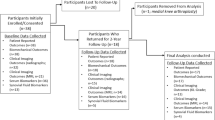Abstract
The aims of the study were to (i) determine the prevalence and course of self-reported knee instability at 2-year follow-up and (ii) identify factors predictive of retention of self-reported knee instability among patients with established knee osteoarthritis (OA). Among 201 patients from the Amsterdam Osteoarthritis (AMS-OA) cohort, demographic characteristics, self-reported knee instability, muscle strength, proprioception, pain, and physical function were assessed at baseline and at 2 years. Exercise over the past 2 years was assessed by evaluating the medical files. The course of self-reported knee instability was determined in patients reporting instability at baseline. Baseline predictors of self-reported knee instability were determined by uni- and multivariable logistic regression analyses. At baseline, 123 (61 %) patients reported knee instability, and of these, 85 (64 %) patients reported instability 2 years later, while 38 (29 %) reported no instability 2 years later. Poor proprioception and high pain assessed at baseline predicted retention of self-reported knee instability at 2 years among patients with self-reported instability at baseline. Knee instability is highly prevalent among patients with knee osteoarthritis. In patients with self-reported knee instability, the majority retained instability over 2 years. Poor proprioception and high pain predicted retention of self-reported knee instability over time.
Similar content being viewed by others
References
Felson DT, Niu J, McClennan C, Sack B, Aliabadi P, Hunter DJ, et al. (2007) Knee buckling: prevalence, risk factors, and associated limitations in function. Ann Intern Med 147(8):534–540
Van der Esch M, Knoop J, van der Leeden M, Voorneman R, Gerritsen M, Reiding D, et al. (2012) Self-reported knee instability and activity limitations in patients with knee osteoarthritis: results of the Amsterdam osteoarthritis cohort. Clin Rheumatol 31(10):1505–1510
Knoop J, van der Leeden M, Van der Esch M, Thorstensson CA, Gerritsen M, Voorneman RE, et al. (2012) Association of lower muscle strength with self-reported knee instability in osteoarthritis of the knee: results from the Amsterdam Osteoarthritis cohort. Arthritis Care Res (Hoboken) 64(1):38–45
Skou ST, Wrigley TV, Metcalf BR, Hinman RS, Bennell KL (2014) Association of knee confidence with pain, knee instability, muscle strength, and dynamic varus-valgus joint motion in knee osteoarthritis. Arthritis Care Res (Hoboken) 66(5):695–701
Fitzgerald GK, Piva SR, Irrgang JJ (2004) Reports of joint instability in knee osteoarthritis: its prevalence and relationship to physical function. Arthritis Rheum 51(6):941–946
Sharma L, Chmiel JS, Almagor O, Moisio K, Chang AH, Belisle L, Zhang Y, Hayes KW (2015) Knee instability and basic and advanced function decline in knee osteoarthritis. Arthritis Care Res (Hoboken) 67(8):1095–1102
Fleeton G, Harmer AR, Nairn L, Crosbie J, March L, Crawford R, et al. (2015) Self-reported knee instability before and after total knee replacement surgery. Arthritis Care Res (Hoboken)
Kumar D, Swanik CB, Reisman DS, Rudolph KS (2014) Individuals with medial knee osteoarthritis show neuromuscular adaptation when perturbed during walking despite functional and structural impairments. J Appl Physiol 116(1):13–23
van der Esch M, Steultjens M, Harlaar J, Knol D, Lems W, Dekker J (2007) Joint proprioception, muscle strength, and functional ability in patients with osteoarthritis of the knee. Arthritis Rheum 57:787–793
Fransen M, McConnell S, Harmer AR, Van der Esch M, Simic M, Bennell KL (2015) Exercise for osteoarthritis of the knee: a Cochrane systematic review. Br J Sports Med 49(24):1554–1557
Knoop J, Dekker J, van der Leeden M, van der Esch M, Thorstensson CA, Gerritsen M, Voorneman RE, Peter WF, de Rooij M, Romviel S, Lems WF, Roorda LD, Steultjens MP (2013) Knee joint stabilization therapy in patients with osteoarthritis of the knee: a randomized, controlled trial. Osteoarthr Cartil 21(8):1025–1034
Fitzgerald GK, Piva SR, Gil AB, Wisniewski SR, Oddis CV, Irrgang JJ (2011) Agility and perturbation training techniques in exercise therapy for reducing pain and improving function in people with knee osteoarthritis: a randomized clinical trial. Phys Ther 91(4):452–469
Altman R, Asch E, Bloch D, Bole G, Borenstein D, Brandt K, Christy W, Cooke TD, Greenwald R, Hochberg M, et al. (1986) Development of criteria for the classification and reporting of osteoarthritis. Classification of osteoarthritis of the knee. Diagnostic and Therapeutic Criteria Committee of the American Rheumatism Association. Arthritis Rheum 29:1039–1049
Irrgang JJ, Snyder-Mackler L, Wainner RS, FH F, Harner CD (1998) Development of a patient-reported measure of function of the knee. J Bone Joint Surg Am 80:1132–1145
Hurkmans EJ, van der Esch M, Ostelo RW, Knol D, Dekker J, Steultjens MP (2007) Reproducibility of the measurement of knee joint proprioception in patients with osteoarthritis of the knee. Arthritis Rheum 57(8):1398–1403
Bellamy N, Buchanan WW, Goldsmith CH, Campbell J, Stitt LW (1988) Validation study of WOMAC: a health status instrument for measuring clinically important patient relevant outcomes to antirheumatic drug therapy in patients with osteoarthritis of the hip or knee. J Rheumatol 15:1833–1840
Roorda LD, Jones CA, Waltz M, Lankhorst GJ, Bouter LM, van der Eijken JW, Willems WJ, Heyligers IC, Voaklander DC, Kelly KD, Suarez-Almazor ME (2004) Satisfactory cross cultural equivalence of the Dutch WOMAC in patients with hip osteoarthritis waiting for arthroplasty. Ann Rheum Dis 63:36–42
Buckland-Wright JC, Wolfe F, Ward RJ, Flowers N, Hayne C (1999) Substantial superiority of semiflexed (MTP) views in knee osteoarthritis: a comparative radiographic study without fluoroscopy, of standing extended semiflexed (MTP), and schuss views. J Rheumatol 26:2664–2674
Altman RD, Gold GE (2007) Atlas of individual radiographic features in osteoarthritis, revised. Osteoarthr Cartil 15(Suppl A):A1–56
Steyerberg EW (2009) Selection of main effects. Clinical predictions models, a practical approach to development, validation, and updating. Springer, New York, pp. 191–211
Neogi T, Frey-Law L, Scholz J, Niu J, Arendt-Nielsen L, Woolf C, Nevitt M, Bradley L, Felson DT (2015) Sensitivity and sensitisation in relation to pain severity in knee osteoarthritis: trait or state? The Multicenter Osteoarthritis (MOST) Study. Ann Rheum Dis 74(4):682–688
Neogi T, Guermazi A, Roemer F, Nevitt MC, Scholz J, Arendt-Nielsen L, Woolf C, Niu J, Bradley LA, Quinn E, Frey Law L (2016) Association of Joint Inflammation with Pain Sensitization in Knee Osteoarthritis: the Multicenter Osteoarthritis Study. Arthritis Rheumatol 68(3):654–661
Cho YR, Hong BY, Lim SH, Kim HW, Ko YJ, Im SA, Lee JI (2011) Effects of joint effusion on proprioception in patients with knee osteoarthritis: a single-blind, randomized controlled clinical trial. Osteoarthr Cartil 19(1):22–28
Author information
Authors and Affiliations
Corresponding author
Ethics declarations
Disclosures
None.
Additional information
Significance and innovation
• Self-reported knee instability is highly prevalent among patients with osteoarthritis of the knee.
• The majority of patients with self-reported knee instability retained self-reported knee instability over time.
• Poor knee proprioception and high pain predicted retention of self-reported knee instability over time.
Rights and permissions
About this article
Cite this article
van der Esch, M., van der Leeden, M., Roorda, L.D. et al. Predictors of self-reported knee instability among patients with knee osteoarthritis: results of the Amsterdam osteoarthritis cohort. Clin Rheumatol 35, 3007–3013 (2016). https://doi.org/10.1007/s10067-016-3411-x
Received:
Revised:
Accepted:
Published:
Issue Date:
DOI: https://doi.org/10.1007/s10067-016-3411-x




